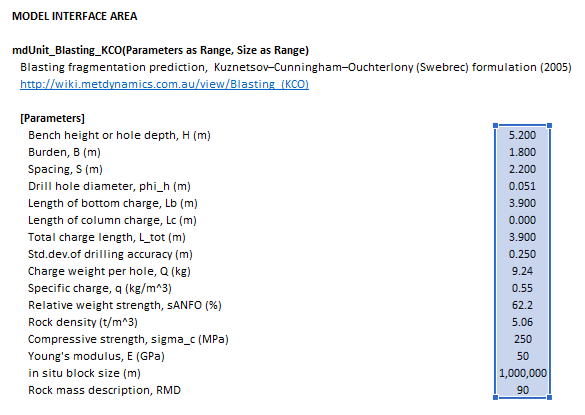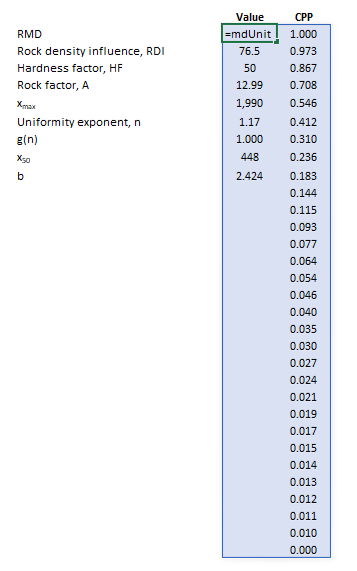Blasting (KCO): Difference between revisions
Jump to navigation
Jump to search
md>Scott.Munro m (→Inputs) |
Scott Munro (talk | contribs) m (1 revision imported) |
(No difference)
| |
Revision as of 04:43, 19 May 2023
Description
This article describes the Kuznetsov–Cunningham–Ouchterlony (KCO) model (Ouchterlony, 2005), also known as the Swebrec function, for predicting rock fragmentation by blasting.[1]
Model theory
Excel
The KOC blasting model may be invoked from the Excel formula bar with the following function call:
=mdUnit_Blasting_KCO(Parameters as Range, Size as Range)
Invoking the function with no arguments will print Help text associated with the model, including a link to this page.
Inputs
The required inputs are defined below in matrix notation with elements corresponding to cells in Excel row () x column () format:
where:
- is the bench height or hole depth (m)
- is Burden (m)
- is Spacing (m)
- is drill hole diameter (m)
- is the length of bottom charge (m)
- is the length of column charge (m)
- is the total charge length, (m)
- is the standard deviation drilling accuracy (m)
- is Charge weight per hole (kg)
- is Specific charge (kg/m3)
- is ANFO relative weight strength (%)
- is rock density (t/m3)
- is compressive strength (MPa)
- is Young's modulus (GPa)
- is in situ block size (m)
- is Rock Mass Description
- is the number of size intervals
- is the size of the square mesh interval that mass is retained on (mm)
- , i.e. descending size order from top size () to sub mesh ( mm)
Results
The results are displayed in Excel as an array corresponding to the matrix notation below:
where:
- is the hardness factor
- is the maximum size parameter of the Swebrec function (mm)
- is the uniformity exponent parameter of the Swebrec function
- is a function parameter of the Swebrec function
- is the mean size parameter of the Swebrec function (mm)
- is an exponent parameter of the Swebrec function
- is the cumulative fraction passing size interval (w/w)
Example
The images below show the selection of input arrays and output results in the Excel interface.
References
- ↑ Ouchterlony, F., 2005. The Swebrec© function: linking fragmentation by blasting and crushing. Mining Technology, 114(1), pp.29-44.

































